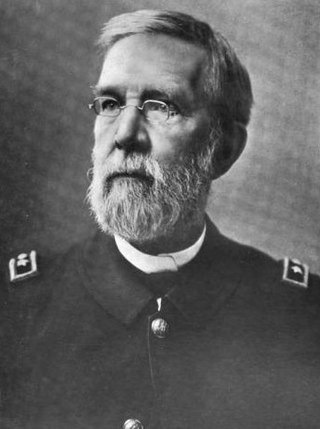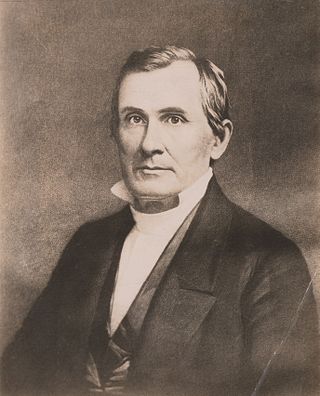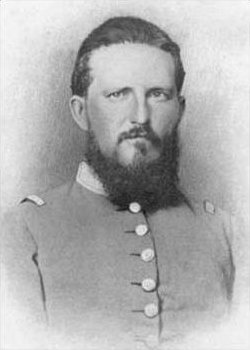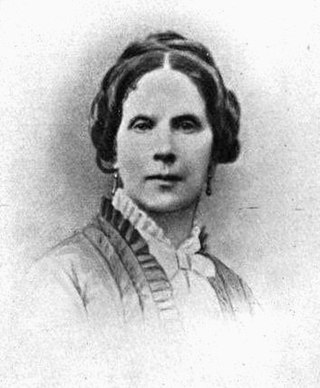
Thomas Jonathan "Stonewall" Jackson was a general officer in the Confederate States Army during the American Civil War. He played a prominent role in nearly all military engagements in the Eastern theater of the war until his death. Military historians regard him as one of the most gifted tactical commanders in U.S. history.

Lexington is an independent city in Shenandoah Valley of Virginia, United States. At the 2020 census, the population was 7,320. It is the county seat of Rockbridge County, although the two are separate jurisdictions, and is combined with it for statistical purposes by the Bureau of Economic Analysis. Lexington is about 57 miles (92 km) east of the West Virginia border and is about 50 miles (80 km) north of Roanoke, Virginia. First settled in 1778, Lexington is best known as the home of the Virginia Military Institute and Washington and Lee University.
William Henry Gilham was an American soldier, teacher, chemist, and author. A member of the faculty at Virginia Military Institute, in 1860, he wrote a military manual which was still in modern use 145 years later. He served in the Confederate Army during the American Civil War, and became president of Southern Fertilizing Company in Richmond after the War.

Robert EmmettRodes was a Confederate general in the American Civil War, and the first of Robert E. Lee's divisional commanders not trained at West Point. His division led Stonewall Jackson's devastating surprise attack at the Battle of Chancellorsville; Jackson, on his deathbed, recommended that Rodes be promoted to major general. Rodes then served in the corps of Richard S. Ewell at the Battle of Gettysburg and in the Overland Campaign, before that corps was sent to the Shenandoah Valley under Jubal Early, where Rodes was killed at the Third Battle of Winchester.

Francis Henney Smith was an American military officer, mathematician and educator. After graduating from West Point and a brief service in the United States Army, he became the first Superintendent of the Virginia Military Institute on its establishment in 1839, and held that post until shortly before his death. His superintendency included the four years of the American Civil War, during which he served as a major general in the Virginia militia and a colonel in the Confederate States Army.
The Stonewall Brigade of the Confederate Army during the American Civil War, was a famous combat unit in United States military history. It was trained and first led by General Thomas J. "Stonewall" Jackson, a professor from Virginia Military Institute (VMI). His severe training program and ascetic standards of military discipline turned enthusiastic but raw recruits into an effective military organization, which distinguished itself from the First Battle of Bull Run in 1861 to Spotsylvania Court House in 1864. Its legacy lives on in the 116th Infantry Brigade, which bears the unofficial nickname "Stonewall Brigade," and in several living history reenactment groups.

William Nelson Pendleton was an American teacher, Episcopal priest, and soldier. He served as a Confederate general during the American Civil War, noted for his position as Gen. Robert E. Lee's chief of artillery for most of the conflict. After the war, Pendleton returned to his priestly duties and also wrote religious materials. Camp Pendleton in Virginia Beach, Virginia, is named in his honor.

Edwin Gray Lee was an American soldier from Virginia and a Confederate brigadier general during the American Civil War. He was a member of the Lee family and first cousin once removed of Robert E. Lee.

Gods and Generals is a 2003 American epic war drama film written and directed by Ronald F. Maxwell. It is an adaptation of the 1996 novel of the same name by Jeffrey Shaara and prequel to Maxwell's 1993 film Gettysburg. Most of the film was personally financed by media mogul Ted Turner. The film follows the story of Stonewall Jackson from the beginning of the American Civil War to his death at the Battle of Chancellorsville.

The Reverend George Junkin was an American educator and Presbyterian minister who served as the first and third president of Lafayette College and later as president of Miami University and Washington College.

Scott Shipp was an American military figure, Confederate States Army officer, educator and educational administrator born in Warrenton, Virginia. He was the second superintendent of the Virginia Military Institute, briefly the president of Virginia Agricultural and Mechanical College and led the VMI Cadets at the Battle of New Market during the American Civil War.

William Thomas Poague was a Confederate States Army officer serving in the artillery during the American Civil War. He later served as Treasurer of the Virginia Military Institute.

Elisha Franklin Paxton was an American lawyer and soldier who served as a Confederate brigadier general during the American Civil War. He died while leading the “Stonewall Brigade“ during the Battle of Chancellorsville.

Alexander Swift Pendleton was an officer on the staff of Confederate Generals Thomas J. Jackson, Richard S. Ewell and Jubal A. Early during the American Civil War.

Margaret Junkin Preston was an American poet and author.

Mary Anna Morrison Jackson was the second wife, and subsequently widow, of Confederate Army general Thomas "Stonewall" Jackson. She was widely known as the "Widow of the Confederacy" for the next 50 years.
J. William Jones was an American Southern Baptist preacher and writer who became known for his evangelism and devotion to the Lost Cause of the Confederacy. During the American Civil War of 1861–1865, the newly ordained Jones was a Confederate chaplain and conducted many revival meetings. Later, he became a campus minister at several universities and in his final years, chaplain for the United Confederate Veterans. After editing the papers of Gen. Robert E. Lee, Jones became the Secretary-Treasurer of the Southern Historical Society for 14 years and served on his denomination's Home Missions Board. He wrote many books about the Lost Cause and Christianity.

Elinor "Ellie" Jackson was the first wife of Thomas J. "Stonewall" Jackson. She died in childbirth a little over a year after their marriage.

John Thomas Lewis Preston was an American educator and military officer from Virginia. He was a primary founder and organizer of the Virginia Military Institute, and was one of its first two faculty members. He also served in the Confederate military during the American Civil War.


















